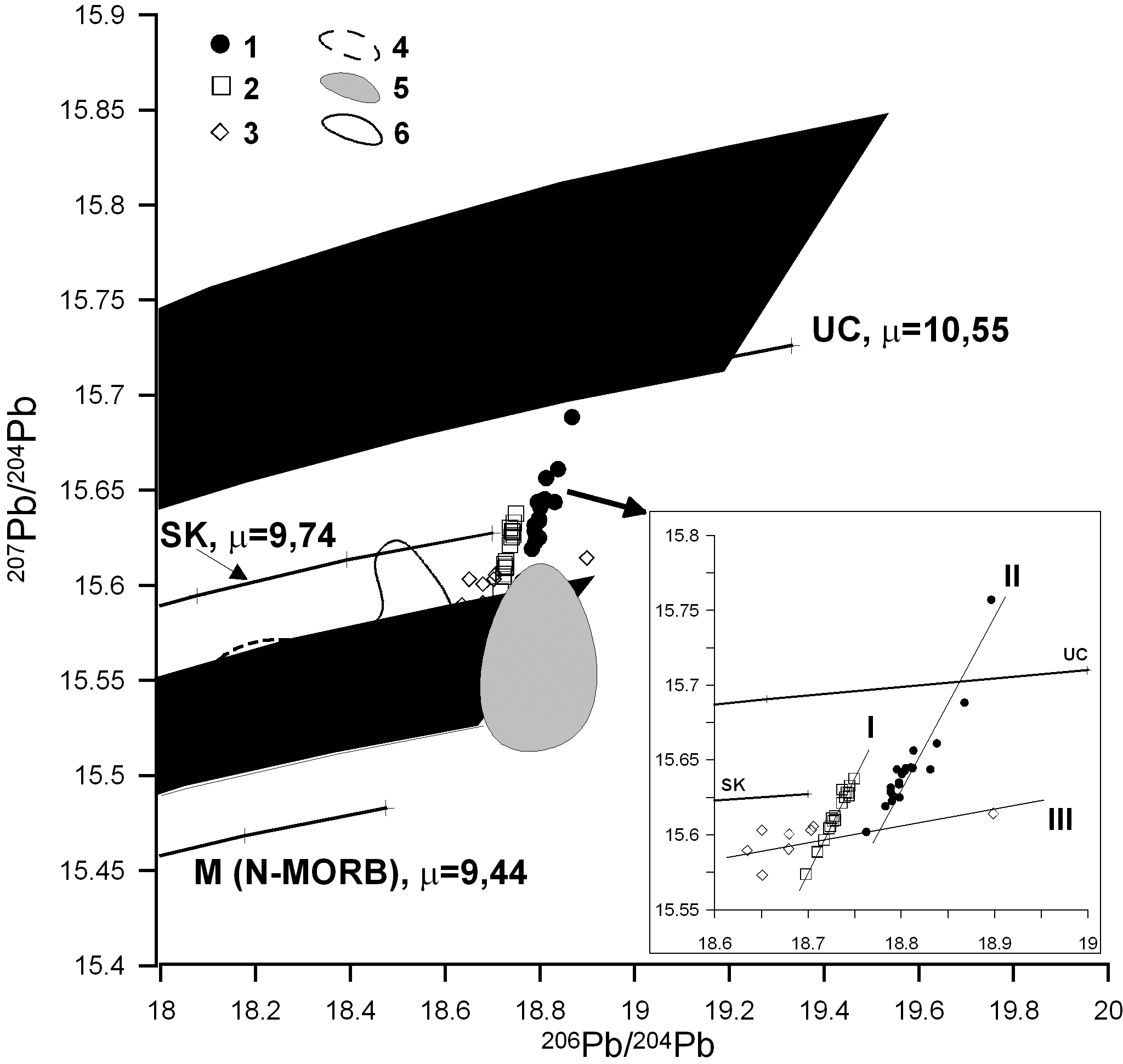|
ISOTOPIC COMPOSITION OF Pb AND SOURCE OF ORE MATTER OF BASE MATAL DEPOSITS, SOUTH-EAST TRANSBAIKALIA Tatarnikov S.A., Dril S.I., Vladimirova T.A., Sasim S.A. Institute of Geochemistry SB RAS, Irkutsk, Russia, stat@igc.irk.ru Forming of numerous base metal Pb-Zn deposits in East Transbaikalia is associated with episodes of intraplate magmatic activity which was the most intensive in the Jurassic-Cretaceous. To reveal sources of ore matter for these deposits, we studied Pb isotopic composition of sulfide minerals of some typical and well studied deposits of this type. Isotopic composition of ore Pb was investigated for Mylnikovsko-Khorkirinskoe and Pochekuevskoe deposits. Both deposits are found in the zone of Kir-Kirinskiy massif of rare-metal morion granites of the Kukulbey complex. The first deposit is located in the zone of dolomites and limestones of the Nortuysk suite among Paleozoic granites. The age of suite is Riphean (Sanin, Zorina, 1978, Geological structure…, 1997). The second deposit is found in the zone tectonic dislocations and confined to limestones and schist of Birkinskaya suite (Arkhangelskaya, 1963, Geologic structure…, 1997). The Akatuy deposit is found on north part of Aleksandorv-Zavodskaya rift depression close to the Akatuy massif of monzonites and Akatuy intrusive complex. All ore bodes are located in the Riphean limestone rocks of the Nortuysk suite.
Results obtained from studies of isotopic composition of Pb in galena, blendes and pyrites are shown on figure 1 for three deposits. All isotopic compositions of ore Pb are anomalous and can be interpreted as lines of mixing of Pb of different geochemical reservoirs: earth's crust and mantle. Lines of mixing of Pb for Milnikovsko-Khorkirinskoe and Pochekuevskoe deposits (trend I and II) determine the evolution of ore Pb for these deposits. The matter of upper crust with μ=10,55 and higher can be regarded as the crust source of lead. Composition of terrigenous sediments of passive continental margins satisfy this condition (Fig.1). The metaterrigenous rocks of the Birkinskaya suite of the Argunsky superterrane composing the major part of host rocks of deposits in the Klichka ore district can be regarded as terrigenous sediments of the passive continental margin (Parfenov, Popeko, Tomurtogoo, 1999). Lines of mixing of ore Pb of Akatuy deposit (trend III on incut) indicate other nature of crustal Pb source. The Neoproterozoic carbonate rocks of the Nortuysk suite can be regarded as such source. They host the mineralization. Nature of mantle source of matter can be confidently determined for ore Pb of the Akatuy deposit, as the trend evolution in its less radiogenic part adjoins the field of composition of gabbro- monzonite- monzonitic rock series of Akatuy massif. Granites of the Kir-Kirinskiy massif can be considered as the endogenous source for Milnikovsko-Khorkirinskoe and Pochekuevskoe deposits. Investigations are supported by grant RFBR 05-05-64332, 06-05-64754, 08-05-00660.
References Arkhangelskaya V.V. Lead-zinc deposits of the Klichka ore district. : Problem of Geology and geesis of some lead-zinc deposits of the Eastern Transbaikalia..Publishing House of USSR Academy of Sciences. 1963. P.94-141. Parfenov L.M., Popeko L.I., Tomurtogoo Î. Problems of tectonics of the Mongol-Okhotsk origenic belt // Pacific Geology 1999. V.18. ¹5. P.24-43. Sanin B.P., Zorina L.D. Geology and geochemistry of the Klichka ore district. Nauka, Novosibirsk. 1978. 177p. Cohen R.S., O,Nions R.K. The lead, neodymium and strontium isotopic structure of ocean ridge basalts //Journal of Petrology 1982, V.23. P.299-324. Mattinson J.M. Preparation of the HF, HCl, HNO3 acids at ultra low lead levels// Analitical Chemistry. 1972. v.44. ¹8. P.1715-1716. Miller D.M., Goldstein S.L., Langmuir Ch. H. Cerium/lead isotope ratios in arc magmas and the enrichment of lead in the continents//Nature V. 368. 1994. P.514-520. Stacey J.S., Kramers J.D. Approximation of terrestrial lead isotope evolution by two-stage model// Earth Planet. Sci. Lett. 1975. V.26. P.207-221. William M., Dupre B., Vidal P. Isotope and trace element geochemistry of sediments from the Barbados Ridge-Demerara Plain region, Atlantic Ocean.// Geochimica et Cosmochimica Acta, vol. 49 P.1875-1886, 1985. Zartman R.E., Haines S.M. The plumbotectonic model for Pb isotopic systematics among major terrestrial reservoirs – a case for bi-directional transport // Gechim. Cosmochim. Acta. 1988. V.52. P.1327-1339. |
